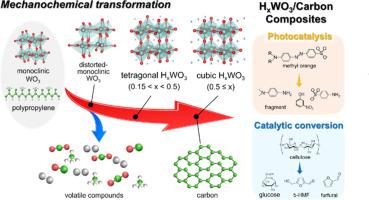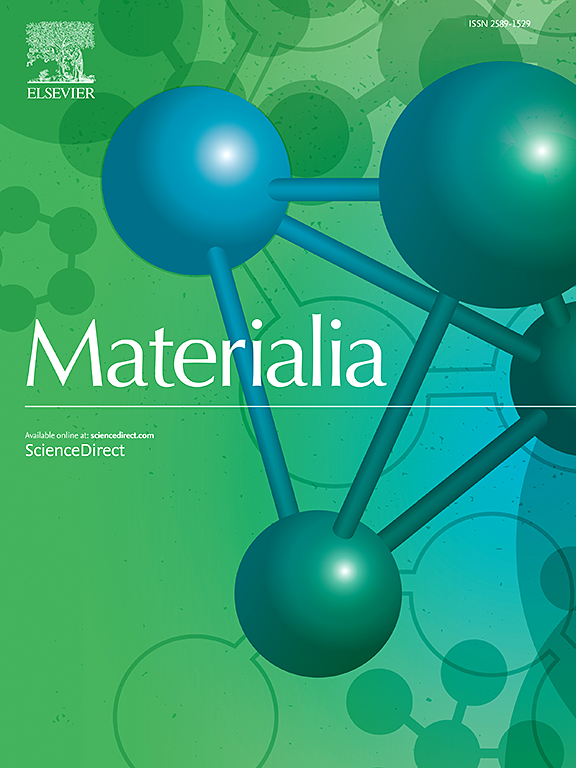用于生物质转化和太阳能水净化的双功能氢钨青铜/碳复合催化剂
IF 3
Q2 MATERIALS SCIENCE, MULTIDISCIPLINARY
引用次数: 0
摘要
我们提出了一种由 HxWO3 和碳复合材料组成的新型双功能催化剂,它在生物质转化中表现出优异的催化活性,并能通过光谱中的宽波长有效净化水。HxWO3/ 碳复合材料是由市售的单斜三氧化钨(WO3)和聚丙烯(PP)粉末通过高能球磨一步机械化学反应有效制得的。我们系统地研究了不同的合成参数,如转速、加工持续时间和球直径,如何影响行星球磨过程中机械化学诱导的向四方或立方 HxWO3 的相变。通过改变球磨过程中的总冲击能量,可以控制 HxWO3 的晶相。此外,对罐内压力增量的实时监测和对挥发气体的评估揭示了 WO3 在 PP 氧化降解过程中的脱气行为。CV 和里特维尔德分析证明,与单斜 WO3 相比,HxWO3 的 H+ 扩散速率显著提高了两个数量级。这种提高可归因于机械形成的隧道沿 a 轴扩展,从而促进了 H+ 离子的迁移。与未经处理的 WO3 相比,HxWO3/碳复合材料通过催化水解纤维素生成可溶性固体(葡萄糖和糠醛衍生物)的效率要高出约 12 倍,这是由于布氏酸性增强的缘故。此外,复合颗粒在紫外-可见-近红外范围内表现出广泛的光吸收,在近红外和可见光照射下,甲基橙污染物的光催化降解能力显著增强了三个数量级以上。本文章由计算机程序翻译,如有差异,请以英文原文为准。

Bi-functional hydrogen tungsten bronze/carbon composite catalysts towards biomass conversion and solar water purification
We presented a novel bi-functional catalyst composed of HxWO3 and carbon composites, which exhibits excellent catalytic activity in biomass conversion and can effectively purify water via a wide range of wavelengths in the light spectrum. The HxWO3/carbon composites were effectively produced from commercially available monoclinic tungsten trioxide (WO3) and polypropylene (PP) powders to a single-step mechanochemical reaction employing high-energy ball milling. We systemically investigated how different synthesis parameters, such as rotation speed, processing duration, and ball diameter, affect the mechanochemically-induced phase transformation to either tetragonal or cubic HxWO3 during planetary ball milling. The crystal phase of HxWO3 was controllable by altering the total impact energy in the ball milling. In addition, real-time monitoring of the pressure increment inside the pot and evaluation of the evolved gas revealed the degassing behavior through the oxidative degradation of PP assisted by WO3. The CV and Rietveld analysis proved that HxWO3 exhibited significant enhancement by two orders of magnitude in the rate of H+ diffusion compared to monoclinic WO3. This enhancement would be attributed to the expansion of a mechanically-formed tunnel along the a-axis, which facilitates the migration of H+ ions. The HxWO3/carbon composites performed approximately 12-fold higher efficiency in generating soluble solids (glucose and furfural derivatives) compared to untreated WO3 through the catalytic hydrolysis of cellulose, owing to the enhanced Brønsted acidity. Moreover, the composite particles showed broad light absorption in the UV–Vis–NIR range and demonstrated a considerable enhancement of over three orders of magnitude in the photocatalytic degradation of methyl orange pollutants when exposed to NIR and visible light.
求助全文
通过发布文献求助,成功后即可免费获取论文全文。
去求助
来源期刊

Materialia
MATERIALS SCIENCE, MULTIDISCIPLINARY-
CiteScore
6.40
自引率
2.90%
发文量
345
审稿时长
36 days
期刊介绍:
Materialia is a multidisciplinary journal of materials science and engineering that publishes original peer-reviewed research articles. Articles in Materialia advance the understanding of the relationship between processing, structure, property, and function of materials.
Materialia publishes full-length research articles, review articles, and letters (short communications). In addition to receiving direct submissions, Materialia also accepts transfers from Acta Materialia, Inc. partner journals. Materialia offers authors the choice to publish on an open access model (with author fee), or on a subscription model (with no author fee).
 求助内容:
求助内容: 应助结果提醒方式:
应助结果提醒方式:


